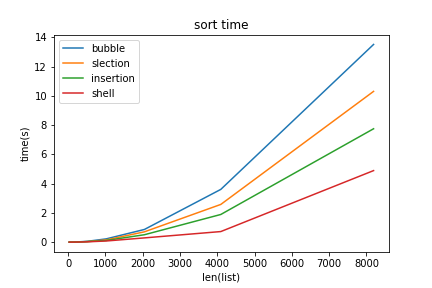基本情報技術者試験のアルゴリズム対策を始めましたので、基礎的なソートプログラムをPythonで書いてみました。下記コードを実行すれば同じようなグラフが描画できると思います。間違いがあればご指摘していただければ幸いです。
使用した言語/ツール
- Python
- Jupyter Notebook
今回登場するソートアルゴリズム
- バブルソート
- 選択ソート
- 挿入ソート
- シェルソート
まずは結果のグラフ
xは32, 64, 128, 256, 512, 1024, 2048, 4096, 8192個のランダムな数値(1から50000)が入ったリストです。
縦軸には実行時間をとっています。
コード
間違いがあれば指摘していただければ幸いです。
import copy
import random
import time
def bubble_sort(list_data):
start = time.time()
sample_data = copy.copy(list_data)
for h in range(len(sample_data)):
for i in range(len(sample_data)-1):
if sample_data[i] > sample_data[i+1]:
a = sample_data[i]
b = sample_data[i+1]
sample_data[i] = b
sample_data[i+1] = a
end = time.time()
result = end - start
return sample_data, result
def selection_sort(list_data):
start = time.time()
sample_data = copy.copy(list_data)
for h in range(len(sample_data)):
m = 0
for i in range(len(sample_data)-h):
if sample_data[m] < sample_data[i]:
m = i
if i == len(sample_data)-1-h:
work = sample_data[i]
sample_data[i] = sample_data[m]
sample_data[m] = work
continue
end = time.time()
result = end - start
return sample_data, result
def insertion_sort(list_data):
start = time.time()
sample_data = copy.copy(list_data)
for i in range(1, len(sample_data)):
if sample_data[i-1] > sample_data[i]:
j = i
while j > 0 and sample_data[j-1] > sample_data[j]:
work = sample_data[j]
sample_data[j] = sample_data[j-1]
sample_data[j-1] = work
j -= 1
end = time.time()
result = end - start
return sample_data, result
def shell_sort(list_data):
start = time.time()
sample_data = copy.copy(list_data)
h = 1
while h < len(sample_data) / 9:
h = h * 3 + 1
while h > 0:
for i in range(h, len(sample_data)):
if sample_data[i-h] > sample_data[i]:
j = i
while j > 0 and sample_data[j-h] > sample_data[j]:
work = sample_data[j]
sample_data[j] = sample_data[j-h]
sample_data[j-h] = work
j -= 1
h = h // 3
end = time.time()
result = end - start
return sample_data, result
time_bubble = list()
time_selection = list()
time_insertion = list()
time_shell = list()
for i in range(5,14):
num = 2**i
print(num)
random.seed(1)
samples = random.sample(range(1, 50000), k=num)
time_bubble.append(round(bubble_sort(samples)[1], 5))
time_selection.append(round(selection_sort(samples)[1], 5))
time_insertion.append(round(insertion_sort(samples)[1], 5))
time_shell.append(round(shell_sort(samples)[1], 5))
# print("{:<16}".format("bubble"), time_bubble)
# print("{:<16}".format("selection"), time_selection)
# print("{:<16}".format("insertion"), time_insertion)
# print("{:<16}".format("shell"), time_shell)
グラフの描画
%matplotlib inline
import numpy as np
import matplotlib.pyplot as plt
x = [32, 64, 128, 256, 512, 1024, 2048, 4096, 8192]
y_bubble = time_bubble
y_selection = time_selection
y_insertion = time_insertion
y_shell = time_shell
plt.title("sort time")
plt.xlabel("len(list)")
plt.ylabel("time(s)")
plt.plot(x, y_bubble, label="bubble")
plt.plot(x, y_selection, label="slection")
plt.plot(x, y_insertion, label="insertion")
plt.plot(x, y_shell, label="shell")
plt.legend()
上のコードの数値を変えれば数字の個数を変更できます。
現在は2の5乗から2の13乗までになっています。
for i in range(5,14):
num = 2**i
print(num)
random.seed(1)
samples = random.sample(range(1, 50000), k=num)
今回わかったこと
- 個数が多いとシェルソートは速い。
- シェルは開発者の名前。
- こういう作業はJupyter Notebookを使うと調子がいいとわかった。
おわりに
実行する環境によって細かな描画が変わってくると思います。ご了承ください。
